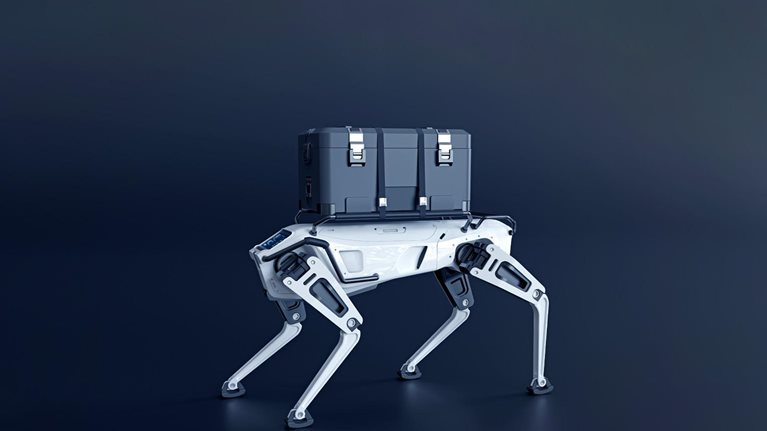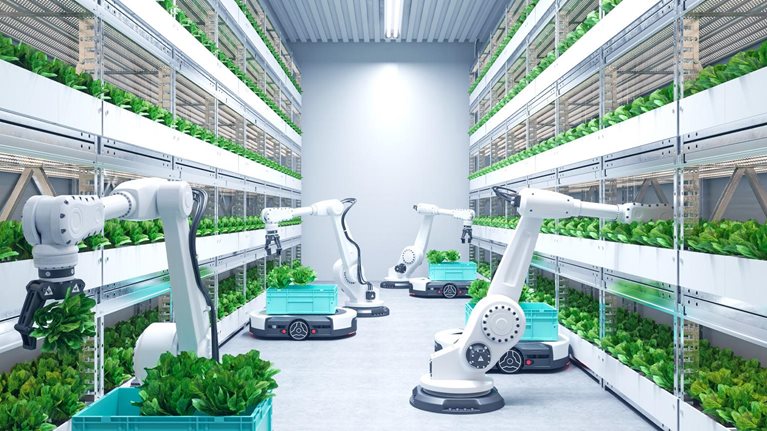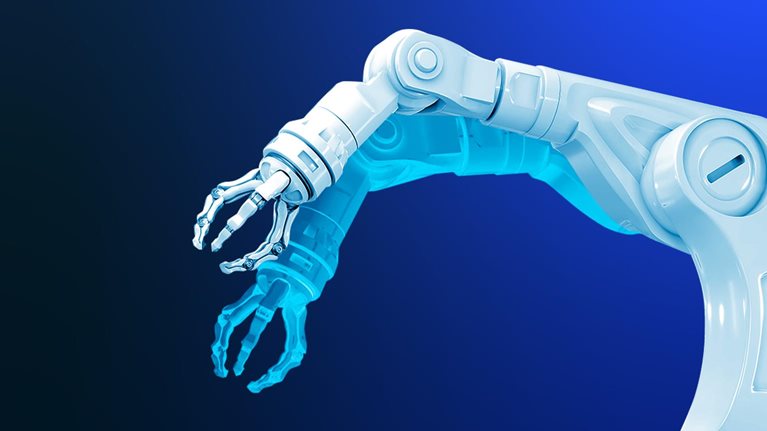Humanoid robots—machines that resemble people in size and shape—have long captured imaginations, offering visions of a future in which they seamlessly integrate into environments designed for humans. Unlike traditional robots optimized for single tasks, humanoids hold the promise of broad adaptability across a wide range of functions. In theory, they could one day serve many industries: assembling parts on production lines, transporting goods in warehouses, supporting nurses in hospitals, stocking shelves in retail, or even assisting with eldercare and household tasks.
Today, however, the gap between what is technically demonstrated in pilots and what is commercially viable at scale remains wide. The prototypes that are capturing headlines are impressive but still far from delivering consistent, reliable, and economically justifiable performance in real-world settings, as noted in our previous articles, “Will embodied AI create robotic coworkers?” and “A leap in automation: The new technology behind general-purpose robots.” To cross the chasm from pilots to large-scale deployment, technology providers must build four “bridges”:
- safety systems for fenceless operations
- sustained uptime
- greater dexterity and mobility
- radical cost reduction
Each bridge marks a decisive threshold across the chasm. Humanoids cannot move from concept to coworker until all four are built. OEMs that address all four will be positioned to scale quickly; those that focus on only some will remain stuck in pilot purgatory. Although full-scale humanoid deployment is years away, executives at companies that are end users of robotic technology must monitor progress on these fronts and start preparing their organizations now, or risk lagging behind competitors when robots become an essential part of the workplace.
Bridge 1: Safety systems for fenceless operations
The true promise of humanoids lies in coexisting freely alongside humans in workplaces and public spaces, rather than working behind barriers. That aspiration sets a higher bar for safety, and reaching it will require both regulatory and technological bridges to be built.
The International Organization for Standardization (ISO) has issued safety guidelines for robotics—ISO 10218 and ISO/TS 15066—but these focus on robot arms and collaborative robots, not autonomous humanoids that move and interact in unstructured settings. Stakeholders in the humanoid ecosystem are now collaborating to create new guidelines. For instance, ISO 25785-1, currently under development, will define humanoid-specific requirements, including those related to fall mitigation, predictable behavior, and compliant interactions. Until new standards are finalized, adopted, and reflected in formal regulations, ambiguity will constrain mainstream humanoid deployment.
In addition to standards and regulations, stakeholders must simultaneously address technology gaps. At present, humanoids still fall short in detecting human intent and adjusting fluidly to crowded spaces. Agility Robotics’ Digit, piloted in Amazon warehouses, illustrates the tension: Equipped with 360-degree vision and LiDAR, it can transport totes, but must still operate in semisegregated areas because of safety concerns.

AI in the Physical World: Looking ahead to CES
Tuesday, December 16 | 10:30 AM EST / 4:30 PM CET Join senior partner Philipp Kampshoff and partner Ani Kelkar as they discuss how general-purpose robotics and autonomous vehicles are ushering in a transformation of the mobility and industrial sectors.
Close collaboration between people and humanoids will require multilayered safety architectures combining vision, tactile sensing, proximity detection, and force-limited actuation, which puts guardrails on the amount of pressure robots can exert. Redundant safeguards—real-time motion planning, compliant limbs with spring-like properties, and fall recovery—must backstop failures. Just as importantly, these safeguards must be evaluated and approved through clear certification pathways and standardized validation tests.
Industry stakeholders should monitor which OEMs are both investing in technical safeguards and actively participating in standards setting, as these firms will be best positioned to scale once an adequate regulatory framework is in place.
Bridge 2: Sustained uptime
Most humanoids still run only two to four hours on a charge—far short of the eight to 12 hours that define real-world shifts. As a result, robots spend too much time idle and cannot deliver productivity comparable to human workers. The primary blocker is the battery. Until OEMs can provide sustained uptime, humanoid deployments will be restricted to pilots.
Two practical pathways are emerging. The first is swappable battery packs designed to click in and out in minutes. This approach keeps robots working through the shift and lets charging happen in the background. The second is fast charging during planned breaks or shift changes, supported by chargers and layouts that make quick “pit stops” simple and safe. Either path should be judged by one standard: Can a robot reliably cover a full shift with minimal interruptions?
Other design choices help but are secondary to the battery decision. More efficient transmissions and lighter structures reduce energy per task; rightsized perception and compute avoid unnecessary power draw and heat; better thermal design prevents slow-downs late in the shift; and quick, reliable recovery from stumbles or minor faults prevents long pauses.
There are also trade-offs to manage when lengthening uptime. Higher-energy batteries extend runtime but raise thermal risk and require stronger protection and monitoring; safer chemistries offer longer life but lower capacity. The goal is certifiable, reliable operation alongside people—not a headline-grabbing lab demo.
Ultimately, real-site characteristics are what matter: guaranteed shift coverage (with swap or charge time specified), the required charging or swap infrastructure, and the safety evidence that allows robots to operate near people without frequent stoppages. Until those pieces are in place, sustained uptime will remain the main barrier to scaling.
Bridge 3: Greater dexterity and mobility
Dexterity and mobility are the most visible areas for improvement, and perhaps the most technically daunting. Current humanoids remain far from human capability in these areas, particularly in unstructured environments. The gaps arise across three dimensions:
- Mechanics. A human hand has roughly 20 to 27 degrees of freedom (DoF), enabling a wide repertoire of grasping, twisting, and in-hand manipulation. By contrast, most robotic hands fall well short in effective DoF, as many joints are coupled and far less independently controlled, sharply limiting their range. Robotic actuators also lag far behind biological muscle in force density, bandwidth, and control. The result: Humanoids can perform simple grasps but lack the nuanced dexterity that underpins many everyday human tasks.
- Sensorimotor skills. Even when extensively trained, humanoid robots struggle with reliable, closed-loop manipulation. Humans achieve similar feats effortlessly, thanks to finely tuned sensorimotor integration that allows them to combine various inputs, including touch and vision, to guide movement. Robots can approximate human precision only under controlled conditions, not in dynamic workplaces.
- Learning efficiency. Robots can now learn by watching humans, either live or in videos, and then copying their actions. Imitation learning is particularly well suited to training for mobility and dexterity. The drawback is that humanoids require billions of simulated interactions to master narrow tasks, with poor generalization. To advance, researchers must create technologies that allow humanoids to perceive their own skill deficits, set goals, and develop improvement strategies. In addition, humanoids will need better tactile sensing skins (layers of electronic sensors on their outer surface that perceive touch) and richer kinematic designs that optimize how mechanical parts are arranged to control motion. Such advances will require breakthroughs in high-performance actuators and dense multimodal sensing (for instance, combining cameras with thermal and tactile inputs). It will also require AI models trained on large, embodied datasets, which allow humanoids to learn from experience. Progress is ongoing, and more efficient actuators, adaptive hands, and foundation models tuned for physical interaction are under development. Despite these recent gains, however, the capability gap remains wide.
The bottom line: Dexterity defines robotic scope. Until humanoids achieve greater mechanical bandwidth and smarter sensorimotor integration, they will remain confined to repetitive, low-complexity tasks in structured environments. For executives, the implication is that near-term pilots should focus on roles in which humanoids’ anthropomorphic form factor is valuable but full dexterity is not essential.
Bridge 4: Radical cost reduction
If dexterity and safety define capability, cost defines viability. Even if humanoids gain new skills and can freely move about the workplace, they will not scale unless they are affordable. Driven by overengineered subsystems and immature supply chains, product costs for today’s prototypes typically range from $150,000 to $500,000 per unit. These high costs are unsurprising: Early generations focus on technical feasibility, which demands substantial resources.
Once companies have achieved proof of concept, they often shift their focus to cost reductions—a common pattern across industries. For instance, smartphone manufacturers reduced costs by collapsing dozens of discrete components into a single system-on-chip for later generations. This architectural choice cut the bill of materials (BOM), reduced power circuitry, and simplified assembly at scale while boosting system performance. Building the cost bridge for humanoids will likely follow a similar pattern.
For humanoids to compete with human labor across mainstream sectors, product costs must fall into the $20,000 to $50,000 range per unit; potentially greater reductions may be necessary for humanoids in consumer-facing environments such as homes, retail, and hospitality (see sidebar “Cost drivers in humanoid robots”). Next-generation humanoids will not become affordable by default. Instead, they must be redesigned with cost reduction as a core objective by applying multiple levers, including the following:
- Task-scoped architectures. OEMs should rightsize DoF, payload, sensing, and compute for the first wave of jobs, such as tote handling and inspection, rather than overspecifying for future tasks. This shift will reduce BOM and speed commissioning.
- Modularized mechatronic joints. By integrating motor, gearbox, sensing, drive, and control into sealed, repeatable units—humanoid “systems-on-joint”—companies can reduce part count, wiring, and assembly time.
- Part-count elimination and harness simplification. If companies co-design robotic structure and routing to remove brackets, connectors, and cable length, they may attain major labor and yield gains.
- Platform standardization with a tiered supplier ecosystem. Common joint SKUs, shared interfaces, and multiple sourcing options help drive volume pricing and faster learning curves for actuators, gears, sensors, and safety.
- Serviceability by design. Hot-swap joints or even entire limbs, quick battery exchange, and modular covers reduce downtime labor, lowering total cost of ownership even before unit prices decline.
- Rightsized perception/compute. OEMs should migrate from “research-grade” stacks to deployment-grade modules and edge compute sized for the actual task envelope.
Beyond design changes, OEMs pursuing actuator innovation and supply-chain localization could gain a decisive edge in reducing costs and unlocking broad commercial adoption. Partnerships that focus on joint innovation could also help.
Early lessons from pilots
Two factors determine where humanoids work today (Exhibit 1):
- task complexity (how much manipulation, decision-making, and adaptation a task demands)
- environmental stability (how predictable and structured the setting is)

The first commercial pilots involved humanoids performing repetitive, moderately complex tasks in structured, low-variability environments such as mapped factory aisles, controlled warehouse lanes, or routine inspection routes. In these settings, humanoids already demonstrate value with their current mobility and basic handling skills.
Recent pilots continue to follow this pattern. In automotive and warehousing, robots are tested primarily for moving components and totes in mapped areas, emphasizing mobility over fine manipulation. At brownfield sites designed for humans, their anthropomorphic footprint is a benefit. Where safety policy is less permissive (for example, mixed-traffic warehouse aisles), humanoid operations remain semisegregated, underscoring the need for safety systems that allow fenceless operations. In hazardous industrial settings, early trials show that humanoids can help keep people out of harm’s way; their form factor is an advantage for inspection, navigating stairs, catwalks, and panels. Across these contexts, the lesson is consistent: Today’s wins come from predictable routes and repeatable tasks, not from high-dexterity assembly (see sidebar “Humanoids in action” for concise use-case examples in automotive logistics, warehouse tote handling, and hazardous-site inspection).
Humanoid constraints must be addressed in sequence. Safety systems for fenceless operations must mature first; without regulatory compliance, robots cannot leave controlled zones. Sustained uptime is the second priority because it is the key driver of ROI and shift-equivalent operation is essential for scale. Dexterity and mobility still limit the range of tasks but are not, by themselves, a deal breaker in these early use cases; improvements here expand the portfolio beyond transport and inspection. Finally, broad rollout depends on radical cost reduction so that systems are affordable beyond pilots and brand showcases (with lower price points required for humanoids in consumer-facing roles).
Regional ecosystems: Different pathways across the chasm
Globally, about 50 companies have declared ambitions in humanoid robotics, but fewer than ten have advanced to scaled pilots or precommercial deployments (Exhibit 2). The majority are still in research and development phases, testing prototypes in labs or in highly controlled environments. This landscape raises two questions for executives: Who will ultimately succeed, and how will regional ecosystems shape the race?

China: Scale through speed, supplier-led innovation, and strategic policy
China has emerged as the fastest-moving ecosystem for humanoid robotics, propelled by strong state direction and an agile supply base. The Ministry of Industry and Information Technology (MIIT) issued a 2024 road map calling for a full-stack humanoid ecosystem by 2025. This policy framework incentivizes domestic component production, sets national benchmarks for humanoid dimensions and safety, and funds pilots in logistics hubs and factories. The effects are already visible: More than 35 new humanoid models were launched in 2024 alone, far outpacing any other region.
The leading Chinese players illustrate the national formula:
- UBTech has leveraged its government-backed presence to roll out large numbers of its Walker robots into inspection and logistics pilots, benefiting from the country’s push for deployment scale.
- Fourier Intelligence, drawing on a network of local component suppliers, is integrating humanoid mobility into healthcare and industrial scenarios. The company’s efforts demonstrate how supplier co-innovation shortens development cycles and lowers costs.
- Unitree, perhaps the most striking case, embodies China’s speed-and-scale dynamic. Its humanoids have made headlines for being priced under $10,000, dramatically lowering the entry threshold, but those gains come at a cost. The company’s humanoids have limited safety features and negligible payload capacity, meaning they are more suited to demonstration and research than industrial deployment. Even so, their rapid release signals how fast iteration and aggressive cost reductions can mobilize markets.
China’s strategy mirrors its earlier success in electric vehicles and industrial robots: Mobilize a broad supplier base, incentivize experimentation, and flood the market with models until cost and capability converge. While many Chinese humanoids still lag on dexterity, safety, and uptime, the velocity and breadth of supplier-led innovation, reinforced by government policy, give China the potential to build the four chasm-crossing bridges faster than expected—and to shape global standards through sheer scale.
North America: Vertical integration and proprietary stacks
North American humanoid companies are largely betting on vertical integration—designing their own actuators, control systems, and AI stacks, rather than relying on suppliers. The belief is that tighter ownership of the full system will deliver superior performance, stronger safety cases, and defensible intellectual property (IP).
Tesla’s Optimus illustrates this model most clearly. The latest prototypes use fully custom actuators and rely on Tesla’s broader AI infrastructure to analyze visual inputs on its Dojo platform to train AI models. By reusing these elements from its vehicle program, Tesla can optimize visual perception and control IP. Figure AI is pursuing a similar approach at BMW’s Spartanburg plant, in one of the first automotive-scale tests of humanoids on a production line. Apptronik’s Apollo humanoid combines in-house design with knowledge from its partner, Mercedes-Benz. These co-development efforts signal that North American firms see long-term value in developing proprietary stacks and validating them with blue-chip manufacturing use cases.
Agility Robotics is a partial exception to the North American norms, in that the company outsources some hardware modules but keeps system integration and software in-house. Its pilots with Amazon and GXO, supported by the Agility Arc orchestration platform, reflect a pragmatic balance: The company maintains control of the critical software and data loops while leveraging external partners for faster scaling.
Compared to China’s supplier-led cost-down model, the North American approach is slower and more capital-intensive. But it reflects a conviction that owning the stack—from actuators to data pipelines—will enable more reliable, certifiable robots in complex brownfield environments where safety, compliance, and performance cannot be compromised.
Europe: Building the trusted humanoid corridor
European OEMs are charting distinct pathways for safety, compliance, and human-first design:
- Neura Robotics in Germany positions itself as a pioneer of cognitive humanoids, combining multimodal perception, intent prediction, and proactive safety features with innovations such as high-resolution sensor skins.
- PAL Robotics in Spain builds on decades of wheeled mobile and service robot leadership—platforms like ARI and TIAGo—and incorporates its navigation, location/mapping technology, and safety design into biped humanoids such as TALOS.
- 1X, founded in Norway and now backed by OpenAI, is advancing its NEO and EVE androids with a clear focus on embodied AI—robots that can operate autonomously and safely in human environments.
- Engineered Arts in the UK focuses on expressive human-robot interaction with its humanoid, Ameca.
These companies reflect Europe’s emphasis on safety, compliance, and human‑first design as core differentiators. They leverage tactile sensing, proven navigation, embodied AI, and expressive interaction to build trust as much as capability.
Europe’s greatest advantage lies in its component suppliers and regulatory clarity. Precision drives, actuators, sensors, and safety systems form a strong industrial base. The EU AI Act (2025) and the EU Machinery Regulation (effective in 2027) provide a certifiable path for deploying humanoids in regulated sectors. This combination positions Europe as a trusted humanoid corridor, even if scaling speed lags China and the United States.
Other regions: Resource-driven variation
The degree of vertical integration or supplier reliance in other Asian countries besides China often depends on funding availability and local industrial capacity. Some players in Japan and South Korea emphasize high-performance mechatronics (combined mechanical and electrical engineering); others pursue niche applications.
Strategic questions for leadership
Robotics companies worldwide are clearly following divergent pathways to cross the chasm. The open question for executives is which pathway will build the four bridges fastest. Each approach offers lessons: China shows the power of supply chain ecosystems, the United States highlights the importance of control, and Europe underscores trust and safety. Leaders evaluating partnerships or investments should weigh not just individual OEMs but the strength of their surrounding ecosystems, since no company will be able to cross the chasm alone.
Regardless of region, leaders should remember that crossing the chasm will not hinge solely on technology. It requires coordinated choices across OEMs, suppliers, end users, and investors. The questions below can serve as board-level prompts that link directly to the four bridges—safety, sustained uptime, dexterity and mobility, and cost—and also cover adoption, ecosystem management, and defensibility.
For humanoid robot OEMs
- How close is the platform to performing commercially relevant tasks reliably, with full dexterity and mobility, and which applications should we prioritize over the next three to five years?
- What is the road map to certifiable fenceless operations (standards, test plans, audits), and how will we demonstrate safety to regulators and customers?
- Which strategies—task scoping, actuator redesign, supplier co-innovation—will deliver a tenfold cost reduction without compromising IP or performance?
- Which path (battery swap, fast charging, system-level redesign) will be the first to provide the uptime equivalent to a typical labor shift, and how will it be validated in the field?
- Who owns the sensorimotor/embodied AI data loops, and how will that ownership advantage compound over time?
For suppliers (actuators, sensors, safety, compute, integrators)
- Along the value chain, should we position ourselves as narrow component specialists or strategic co-development partners embedded in OEM road maps?
- How will offerings align with global standards and certification pathways to become trusted Tier 1/Tier 2 modules, rather than commoditized parts?
- What scale, reliability, and life cycle support (such as spares, service, and upgrades) will differentiate us as volumes rise?
- How will we contribute to OEM cost reduction and uptime targets across multiple product generations while protecting our own margins?
For end users (manufacturing, logistics, healthcare, retail)
- Which workflows offer near-term ROI, given today’s limits in humanoid dexterity and uptime, and which workflows should continue to depend on other automation options for now?
- How will we manage fenceless collaboration at scale, including compliance, liability, workforce acceptance, and union engagement?
- What reskilling, safety protocols, and change management systems are required to integrate humanoids into daily operations?
- How will humanoids connect to existing digital systems—including those for enterprise resource planning, warehouse management, and manufacturing execution—and safety infrastructure, rather than becoming siloed?
- What commercial models, such as purchasing robots, using robots as a service (RaaS), uptime service-level agreements, and performance-based fees, best balance incentives and risk?
For investors
- Are there hard indicators—such as certified fenceless safety, shift-equivalent uptime in customer sites, task-reliable dexterity benchmarks, and a documented BOM curve—showing progress on the four bridges?
- What is the target gross margin, manufacturing capacity, supplier capacity, and capital expenditure for 1,000, 10,000, and 100,000 units?
- What are pilot-to-scale conversion rates, cohort payback periods, the share of binding purchase orders compared to letters of intent, and the depth of integrator/enterprise partnerships?
- Who controls the embodied data (collection, labeling, model training), how is it contractually protected, and does it create a genuine flywheel (better models contributing to better performance, which then generates more data)?
- Should capital flow to OEMs pursuing vertically integrated platforms, to suppliers of critical bottleneck components (actuators, sensors, safety systems), or to integrators that incorporate humanoids into brownfield operations? Which layer offers the most durable value capture as the market matures?
- How concentrated is the supply chain (actuators/gears), what are the regulatory and product-liability exposures (for example, the EU AI Act and CE1/ISO timelines, insurance availability), and how resilient is the business to geopolitical constraints and export controls?
Humanoid robots are no longer a curiosity. They are approaching commercial relevance and will scale when they cross all four bridges: safety, sustained uptime, dexterity and mobility, and cost. Companies that prepare early, focus narrowly, and scale deliberately will define the next era of human-machine collaboration. Now is the time to choose where—and how—to cross.


